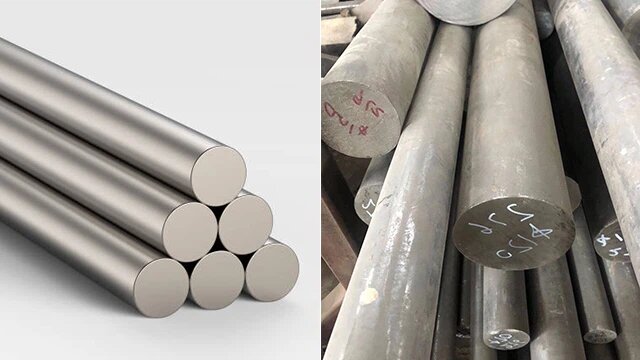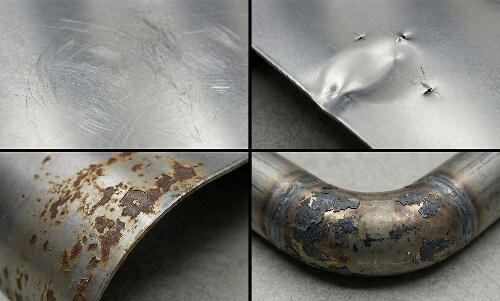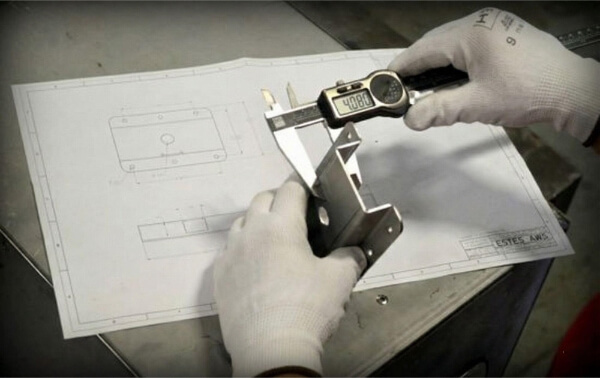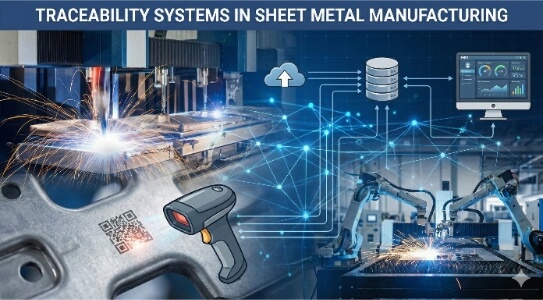Metal selection impacts product durability, cost, and performance. Engineers often face challenges when deciding between alloy and stainless steel for their projects. Poor material choice increases maintenance costs, premature part failure, and project delays. The right steel choice optimizes both performance and budget.
Both alloy steel and stainless steel serve distinct purposes in manufacturing. Alloy steel combines iron with chromium, nickel, and molybdenum to enhance strength and hardness. Stainless steel contains at least 10.5% chromium, creating a protective oxide layer that prevents corrosion. Each type excels in specific applications.
The differences between these metals go beyond basic composition. Let’s examine their unique properties, applications, and cost considerations to help you decide on your next project.

Definition of Alloy Steel
The backbone of modern manufacturing, alloy steel represents a precise blend of iron, carbon, and additional elements designed to achieve specific performance characteristics.
Composition and Characteristics
Alloy steel results from mixing iron with carbon and other elements. The carbon content typically ranges between 0.3% and 1.7%. Adding manganese, chromium, and nickel transforms regular steel into a stronger, more adaptable metal. Heat treatment further enhances these properties, making the steel harder and more durable.
Common Alloys Used
- Chromium-molybdenum steel (4130): Offers excellent strength and toughness
- Nickel-chromium steel (4340): Provides superior wear resistance and strength
- Manganese steel Creates a tough, work-hardening material
- Silicon steel: Enhances magnetic properties and electrical resistance
Advantages of Alloy Steel over Stainless Steel
- Cost-effectiveness: Lower production costs due to fewer alloying elements
- Higher strength-to-weight ratio: Better performance in structural applications
- Easier machining: Requires less specialized tooling and processing
- Better heat treatability: More responsive to hardening processes
Definition of Stainless Steel
A specialized group of steel alloys that combines strength with exceptional corrosion resistance by adding specific elements, primarily chromium.
Composition and Characteristics
Stainless steel stands out due to its minimum 10.5% chromium content. This chromium creates an invisible oxide layer on the surface. When scratched, this layer automatically reforms in the presence of oxygen. The material also contains varying amounts of nickel, molybdenum, and other elements to enhance specific properties.
Types of Stainless Steel
- Austenitic (300 series): Most common, contains 16-26% chromium and 6-12% nickel
- Martensitic (400 series): Higher carbon content, magnetic, and heat-treatable
- Ferritic (400 series): Contains only chromium, magnetic but not heat-treatable
- Duplex: Combines austenitic and ferritic structures for enhanced strength
Advantages of Stainless Steel Over Alloy Steel
- Superior corrosion resistance: Resists rust and oxidation
- Self-healing properties: Oxide layer reforms when damaged
- Excellent hygiene: Easy to clean and sanitize
- Better chemical resistance: Handles aggressive environments

Alloy Steel vs Stainless Steel: Properties Comparison
A detailed analysis of physical and mechanical properties reveals how each steel type performs under real-world conditions. Here is a comparative study of their performance.
Strength and Durability
Alloy steel demonstrates superior tensile strength, often reaching 50% higher values than comparable stainless grades. Heat-treated 4340 alloy steel achieves tensile strengths above 280,000 PSI, while most stainless steels peak around 200,000 PSI. Alloy steel also maintains better wear resistance under heavy loads, making it preferred for gears and bearings.
Corrosion Resistance
Stainless steel dominates in corrosion protection. Its chromium-oxide layer provides continuous protection without additional treatments. Grade 316 stainless steel has been resistant to salt spray for decades, while alloy steel requires protective coatings that need regular maintenance. In chemical environments, stainless steel shows a 5-10 times longer service life.
Ductility and Malleability
Stainless steel, particularly austenitic grades, offers superior formability. These grades stretch 40-60% before breaking, compared to 15-30% for most alloy steels. This characteristic makes stainless steel better suited for complex shapes and deep drawing operations. However, this improved ductility has higher work hardening rates, requiring frequent tool changes.
Thermal Conductivity
Alloy steel conducts heat more efficiently than stainless steel. Its thermal conductivity measures approximately 45 W/m-K, while austenitic stainless steel averages 16 W/m-K. This difference affects manufacturing processes and end-use applications, particularly in heat exchanger designs or high-temperature environments.
Applications of Alloy Steel
Automotive Industry
- Crankshafts made from 4140 alloy steel withstand high torque loads
- Transmission gears using 8620 alloy steel provide reliable power transfer
- Suspension components from 4340 alloy steel absorb road impacts
- Driveshafts require the fatigue resistance of 4130 alloy steel
Construction and Infrastructure
- Bridge support beams utilize high-strength, low-alloy steel
- Heavy equipment frames depend on 4130 alloy steel’s durability
- Foundation reinforcement bars from alloy steel prevent structural failure
- Crane components rely on alloy steel’s superior load-bearing capacity
Manufacturing and Machinery
- Industrial press components from 4340 handle repeated stress cycles
- Machine tool spindles benefit from 4150’s wear resistance
- Industrial robot arms use 8620’s case-hardening properties
- Conveyor system parts leverage 4140’s strength-to-weight ratio
Applications of Stainless Steel
Food and Beverage Industry
- Commercial kitchen equipment uses 304 grade for sanitary surfaces
- Brewing tanks require 316 grade for corrosion resistance
- Food processing conveyors maintain cleanliness with 316L grade
- Storage vessels stay sanitized with 304L stainless steel
Medical Equipment
- Surgical instruments demand 420 grade’s hardness and sterility
- MRI machine components use 316 for non-magnetic properties
- Dental tools rely on 440A’s edge retention
- Laboratory equipment benefits from 316L’s chemical resistance
Aerospace and Automotive Uses
- Exhaust systems utilize 409 grade for heat resistance
- Aircraft fasteners require 17-4 PH’s high strength
- Fuel system components depend on 316’s corrosion resistance
- Structural supports use 301 for its work-hardening capability

Cost Analysis
Raw material selection impacts immediate expenses and long-term financial planning in manufacturing projects. Here is a comparative cost analysis of the two metals.
Initial Costs of Alloy vs. Stainless Steel
Alloy steel typically costs 40-60% less than comparable stainless grades. A ton of 4140 alloy steel averages $1,200, while 304 stainless steel runs about $3,000 per ton. Processing costs also differ – alloy steel machines are faster, reducing labor and tooling expenses. However, coating requirements add 15-25% to the final part cost for alloy steel components.
Long-Term Maintenance Costs
Stainless steel proves more economical over time in corrosive environments. While alloy steel needs repainting or recoating every 2-3 years, stainless steel maintains its protection without intervention. Marine applications show stark differences – alloy steel parts require replacement 3 times more frequently than stainless alternatives due to corrosion damage.
Cost-Benefit Considerations
The choice between these materials demands careful analysis. High-stress applications favor alloy steel’s lower initial cost and superior strength. A typical gear manufacturing operation saves 30% by choosing alloy steel over stainless. However, food processing equipment built from stainless steel reduces contamination risks and cleaning costs by 40% annually compared to coated alloy steel alternatives.
Fabrication and Machining
The fabrication methods and machining characteristics significantly influence production efficiency and final part quality. An exploration of how these materials behave during manufacturing processes and what to expect in production.
Ease of Fabrication for Alloy Steel
Alloy steel responds well to standard fabrication methods. Most grades are cut cleanly with conventional tooling at standard speeds, and the material welds readily with proper pre-heating and cooling procedures. Common fabrication temperatures range from 1600°F to 2200°F.
Shop floor processing proves straightforward. The material forms predictably with standard press brake equipment. Cutting operations require moderate tool wear compensation. Surface finishing follows standard processes without special handling needs.
Heat treatment adds versatility to fabrication. The material accepts various hardening methods to enhance properties. Stress relief after welding helps maintain dimensional stability. Post-fabrication treatments improve wear resistance when needed.
Machining Properties of Stainless Steel
Stainless steel demands more careful machining approaches. Tool life decreases due to work hardening during cutting operations. Speeds typically run 20-30% slower than with alloy steel.
Heat management plays a key role in machining success. Built-up edge formation requires higher speeds and proper cooling. Chip control needs attention to prevent work hardening issues. Regular tool changes help maintain part quality.
Welding requires specific procedures and filler metals. Clean surfaces and proper gas shielding prevent contamination. Post-weld cleaning removes heat tint and restores corrosion resistance.
What Are Similarities Between Alloy and Stainless Steel?
Both materials start with an iron-carbon base. Their fundamental molecular structure builds on this foundation. The manufacturing process begins similarly for both types, involving careful heat control and precise element additions.
Another common trait is manufacturing flexibility. Both metals respond well to standard forming processes. Cutting, bending, and joining work well with proper parameter adjustments.
Tool requirements overlap significantly. Both need carbide tooling for optimal results. Standard machine shop equipment works for both materials. Basic hand tools and power equipment serve both types when properly matched to the specific grade.
Heat treatment enhances both materials and proper temperature control improves their properties. Both respond to conventional heat-treating equipment. Careful cooling rates help achieve the desired characteristics.
Alloy Steel vs Stainless Steel: Selecting the Right Steel for Your Application
Consider these key factors when choosing alloy and stainless steel for your project.
Performance Requirements
- Operating temperature ranges dictate the material choice
- Load-bearing applications favor alloy steel’s strength
- Corrosive environments require stainless steel protection
- Fatigue resistance needs vary by application type
Manufacturing Considerations
- Available machining capabilities and equipment
- Required surface finish specifications
- Production volume requirements
- Assembly method constraints
Economic Factors
- Initial material cost limitations
- Expected product service life
- Maintenance budget allocations
- Replacement part frequency estimates
Industry-Specific Requirements
- Food safety regulations compliance
- Medical grade material specifications
- Aerospace certification requirements
- Automotive safety standards
Conclusion
Selecting alloy and stainless steel requires balancing performance needs, environmental conditions, and budget constraints. Each material serves distinct purposes in modern manufacturing. Alloy steel delivers high strength and cost-effectiveness for structural applications. Stainless steel provides unmatched corrosion resistance and aesthetic appeal. Your specific project requirements will guide the optimal choice.
Beyond material selection, we deliver comprehensive sheet metal fabrication services, from rapid prototyping to mass production. Our advanced manufacturing capabilities in laser cutting, CNC machining, and metal stamping ensure your project meets specifications. Contact our engineering team today to explore the optimal steel solution for your next project.
FAQs
What are the main differences between alloy steel and stainless steel?
Alloy steel combines iron with various elements to boost strength and durability, costing less but requiring surface protection. Stainless steel contains a minimum of 10.5% chromium, creating natural corrosion resistance through a self-healing oxide layer. While alloy steel offers higher strength, stainless steel provides better corrosion protection and appearance retention.
Which steel type is better for high-temperature applications?
The choice of steel for high-temperature environments depends on the temperature range and exposure conditions. Alloy steel grades like 4140 handle temperatures up to 1000°F while maintaining strength. Austenitic stainless steels resist scaling up to 1600°F and resist oxidation better.
What are the disadvantages of alloy steel?
Alloy steel requires surface treatments or coatings for corrosion protection. These protective layers need regular maintenance and replacement. The material oxidizes quickly when exposed to moisture. Welding demands careful pre-heating and post-weld heat treatment.
Is alloy steel rust-proof?
Alloy steel will rust without proper protection. Unlike stainless steel, it lacks the self-protecting chromium oxide layer. Surface treatments like galvanizing, painting, or powder coating provide temporary rust protection. Regular maintenance and reapplication of protective coatings prevent rust formation.
Hey, I'm Kevin Lee

For the past 10 years, I’ve been immersed in various forms of sheet metal fabrication, sharing cool insights here from my experiences across diverse workshops.
Get in touch

Kevin Lee
I have over ten years of professional experience in sheet metal fabrication, specializing in laser cutting, bending, welding, and surface treatment techniques. As the Technical Director at Shengen, I am committed to solving complex manufacturing challenges and driving innovation and quality in each project.




